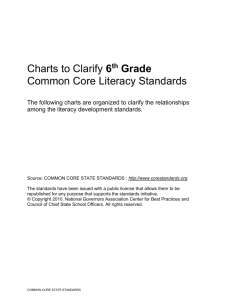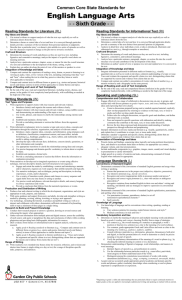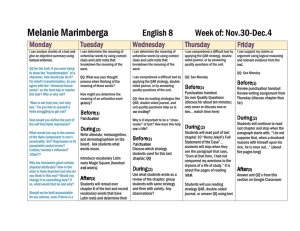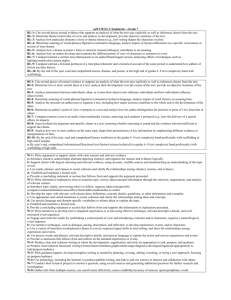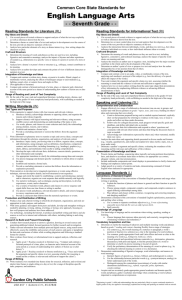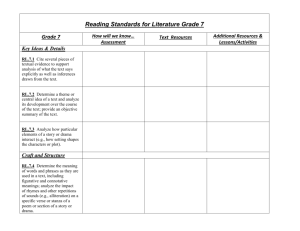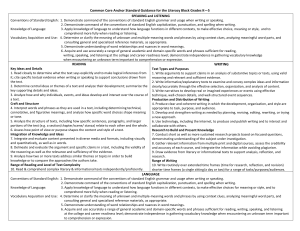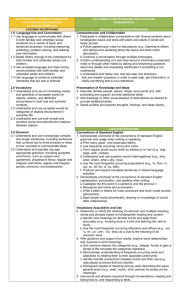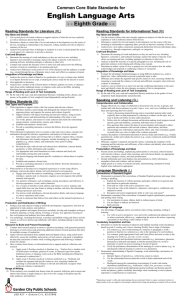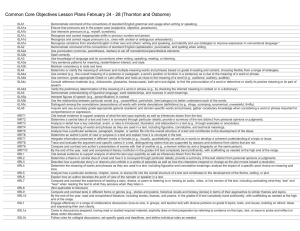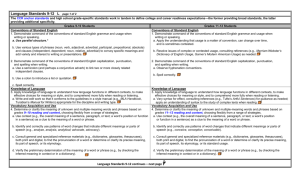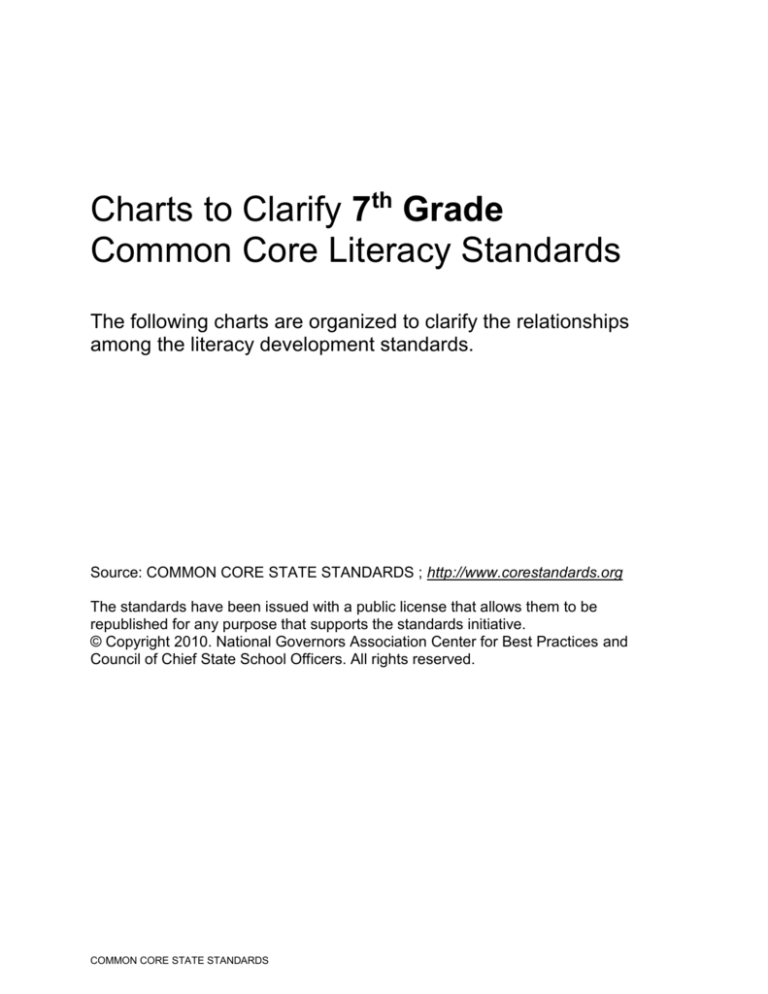
Charts to Clarify 7th Grade
Common Core Literacy Standards
The following charts are organized to clarify the relationships
among the literacy development standards.
Source: COMMON CORE STATE STANDARDS ; http://www.corestandards.org
The standards have been issued with a public license that allows them to be
republished for any purpose that supports the standards initiative.
© Copyright 2010. National Governors Association Center for Best Practices and
Council of Chief State School Officers. All rights reserved.
COMMON CORE STATE STANDARDS
Core Reading Standards for Seventh Grade
LITERATURE
NONFICTION/INFORMATIONAL TEXT
KEY IDEAS AND DETAILS
1. Cite several pieces of textual evidence to
support analysis of what the text says
explicitly as well as inferences drawn from the
text.
2. Determine a theme or central idea of a text
and analyze its development over the course
of the text; provide an objective summary of
the text.
3. Analyze how particular elements of a story or
drama interact (e.g., how setting shapes the
characters or plot).
KEY IDEAS AND DETAILS
1. Cite several pieces of textual evidence to support
analysis of what the text says explicitly as well as
inferences drawn from the text.
CRAFT AND STRUCTURE
4. Determine the meaning of words and
phrases as they are used in a text, including
figurative and connotative meanings; analyze
the impact of rhymes and other repetitions of
sounds (e.g., alliteration) on a specific verse or
stanza of a poem or section of a story or drama.
5. Analyze how a drama’s or poem’s form or
structure (e.g., soliloquy, sonnet) contributes to
its meaning.
6. Analyze how an author develops and
contrasts the points of view of different
characters or narrators in a text.
INTEGRATION OF KNOWLEDGE AND IDEAS
7. Compare and contrast a written story, drama,
or poem to its audio, filmed, staged, or
multimedia version, analyzing the effects of
techniques unique to each medium (e.g.,
lighting, sound, color, or camera focus and
angles in a film).
8. (Not applicable to literature)
9. Compare and contrast a fictional portrayal of a
time, place, or character and a historical
account of the same period as a means of
understanding how authors of fiction use or
alter history.
RANGE AND LEVEL OF TEXT COMPLEXITY
10. By the end of the year, read and comprehend
literature, including stories, dramas, and
poems, in the grades 6–8 text complexity band
proficiently, with scaffolding as needed at the
high end of the range.
COMMON CORE STATE STANDARDS
2. Determine two or more central ideas in a text and
analyze their development over the course of the
text; provide an objective summary of the text.
3. Analyze the interactions between individuals,
events, and ideas in a text (e.g., how ideas
influence individuals or events, or how individuals
influence ideas or events).
CRAFT AND STRUCTURE
4. Determine the meaning of words and phrases
as they are used in a text, including figurative,
connotative, and technical meanings; analyze the
impact of a specific word choice on meaning and
tone.
5. Analyze the structure an author uses to organize
a text, including how the major sections contribute
to the whole and to the development of the ideas.
6. Determine an author’s point of view or purpose
in a text and analyze how the author distinguishes
his or her position from that of others.
INTEGRATION OF KNOWLEDGE AND IDEAS
7. Compare and contrast a text to an audio, video,
or multimedia version of the text, analyzing each
medium’s portrayal of the subject (e.g., how the
delivery of a speech affects the impact of the
words).
8. Trace and evaluate the argument and specific
claims in a text, assessing whether the reasoning
is sound and the evidence is relevant and
sufficient to support the claims.
9. Analyze how two or more authors writing about
the same topic shape their presentations of key
information by emphasizing different evidence or
advancing different interpretations of facts.
RANGE AND LEVEL OF TEXT COMPLEXITY
10. By the end of the year, read and comprehend
literary nonfiction in the grades 6–8 text
complexity band proficiently, with scaffolding as
needed at the high end of the range.
2
The Speaking and Listening Standards are Keys to Learning ACROSS
the Curriculum
Comprehension and Collaboration
SL.7.1 Engage effectively in a range of collaborative discussions (one-on-one, in
groups, and teacher-led) with diverse partners on grade 7 topics, texts, and issues,
building on others’ ideas and expressing their own clearly.
__SL.7.1a Come to discussions prepared, having read or researched material under
study; explicitly draw on that preparation by referring to evidence on the topic,
text, or issue to probe and reflect on ideas under discussion.
__SL.7.1b Follow rules for collegial discussions, track progress toward specific goals
and deadlines, and define individual roles as needed.
__SL.7.1c Pose questions that elicit elaboration and respond to others’ questions
and comments with relevant observations and ideas that bring the discussion
back on topic as needed.
__SL.7.1d Acknowledge new information expressed by others and, when warranted,
modify their own views.
SL.7.2 Analyze the main ideas and supporting details presented in diverse media
and formats (e.g., visually, quantitatively, orally) and explain how the ideas clarify a
topic, text, or issue under study.
SL.7.3 Delineate a speaker’s argument and specific claims, evaluating the
soundness of the reasoning and the relevance and sufficiency of the evidence.
Presentation of Knowledge and Ideas
SL.7.4 Present claims and findings, emphasizing salient points in a focused,
coherent manner with pertinent descriptions, facts, details, and examples; use
appropriate eye contact, adequate volume, and clear pronunciation.
SL.7.5 Include multimedia components and visual displays in presentations to clarify
claims and findings and emphasize salient points.
SL.7.6 Adapt speech to a variety of contexts and tasks, demonstrating command of
formal English when indicated or appropriate.
Students exercise Speaking and Listening competencies as they proceed through
the gradual release of responsibility.
Integrate the Conventions in Writing and Speaking (see the next page).
COMMON CORE STATE STANDARDS
3
LANGUAGE
Seventh Grade
CONVENTIONS IN WRITING AND SPEAKING
1. Observe conventions of grammar and usage.
__a. Explain the function of phrases and clauses in general and their functions in
specific sentences.
__b. Chose among simple, compound, complex, and compound-complex
sentences to signal differing relationships among ideas.
__c. Place phrases and clauses within a sentence, avoiding misplaced and
dangling modifiers.*
2. Observe conventions of capitalization, punctuation, and spelling.
__a. Use a comma before a coordinating conjunction in a compound sentence.
__b. Spell correctly.
3. Make effective language choices.
__a. Choose words and phrases that express ideas concisely, eliminating
wordiness and redundancy.*
VOCABULARY ACQUISITION AND USE
4. Determine word meanings (based on grade 7 reading).
__a. Determine or clarify the meaning of unknown or multiple-meaning words
through the use of one or more strategies, such as using semantic clues (e.g.,
sentence and paragraph context, the organizational pattern of the text); using
syntactic clues (e.g., the word’s position or function in the sentence); analyzing
the word’s sounds, spelling, and meaningful parts; and consulting reference
materials, both print and digital.
__b. Use a known root as a clue to the meaning of an unknown word (e.g.,
belligerent, bellicose, rebel).
__c. Verify the preliminary determination of a word’s meaning (e.g., by checking
the inferred meaning in context or looking up the word in a dictionary).
__d. Interpret various figures of speech (e.g., allegory) relevant to particular
texts.
5. Understand word relationships.
__a. Trace the network of uses and meanings different words have and the
interrelationships among those meanings and uses.
__b. Distinguish a word from other words with similar denotations but different
connotations.
6. Use grade-appropriate general academic vocabulary and English language
arts–specific words and phrases taught directly and gained through reading and
responding to texts.
* Conventions standards noted with an asterisk need to be revisited by
students in subsequent grades.
COMMON CORE STATE STANDARDS
4
WRITING
Seventh Grade
TEXT TYPES AND PURPOSES
1. Write arguments in which they:
__a. Introduce a claim about a topic or issue, acknowledge alternate or opposing claims, and organize the
reasons and evidence logically to support the claim.
__b. Support the claim with logical reasoning and detailed, relevant evidence that demonstrate a
comprehensive understanding of the topic.
__c. Use words, phrases, and clauses to convey the relationships among the claims, reasons, and
evidence.
__d. Sustain an objective style and tone.
__e. Provide a concluding statement or section that follows logically from the argument.
2. Write informative/explanatory texts in which they:
__a. Introduce and establish a topic that provides a sense of what is to follow and organize information
appropriate to the purpose, using strategies such as definition, classification, comparison/contrast, and
cause/effect.
__b. Develop the topic with relevant and accurate facts, definitions, concrete details, quotations, or other
information and examples.
__c. Use appropriate links and varied sentence structures to create cohesion and clarify ideas.
__d. Use precise language and sustain an objective style appropriate for a reader seeking information.
__e. Provide a conclusion that follows logically from the information or explanation presented.
3. Write narratives in which they:
__a. Engage and orient the reader by establishing a context and point of view, and purposefully organize a
sequence of events or experiences.
__b. Develop narrative elements (e.g., setting, conflict, complex characters) with relevant and specific
sensory details.
__c. Use a variety of techniques to convey sequence, shift from one time frame or setting to another,
and/or show the relationships among events or experiences.
__d. Choose words and phrases to develop the events, experiences, and ideas precisely and to create
mood.
__e. Provide a satisfying conclusion that follows from the events, experiences, or ideas.
PRODUCTION AND DISTRIBUTION OF WRITING
4. Produce writing in which the organization, development, substance, and style are appropriate to task,
purpose, and audience. (Grade-specific expectations for writing types are defined in Standards 1–3
above.)
5. With some guidance and support from peers and adults, strengthen writing as needed by planning,
revising, editing, rewriting, or trying a new approach after rethinking how well questions of purpose have
been addressed.
6. Use technology, including the Internet, to produce, publish, and interact with others about writing,
including presenting and citing information in a digital format.
RESEARCH TO BUILD KNOWLEDGE
7. Perform short, focused research projects in response to a question and generate additional related and
focused questions for further research and investigation.
8. Gather relevant information from multiple print and digital sources using search terms effectively; assess
the credibility and accuracy of each source; and quote or paraphrase the data and conclusions of others,
avoiding plagiarism and following a standard format for citation.
9. Write in response to literary or informational sources, drawing evidence from the text to support analysis
and reflection as well as to describe what they have learned.
__a. Apply grade 7 reading standards to literature (e.g., “Analyze a specific case in which a modern work
of fiction draws on patterns of events or character types found in traditional literature (e.g., the hero, the
quest).
__b. Apply grade 7 reading standards to literary nonfiction (e.g., “Identify the stated and unstated premises
of an argument and explain how they contribute to the conclusions reached”).
RANGE OF WRITING
10. Write routinely over extended time frames (time for research, reflection, and revision) and shorter time
frames (a single sitting or a day or two) for a range of tasks, purposes, and audiences.
COMMON CORE STATE STANDARDS
5

